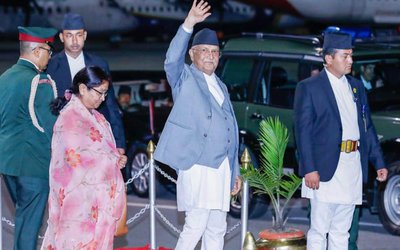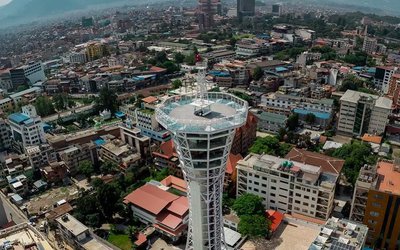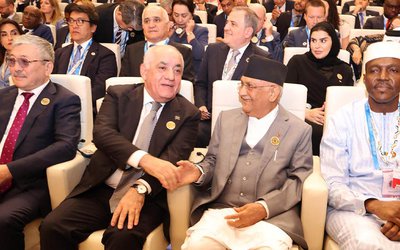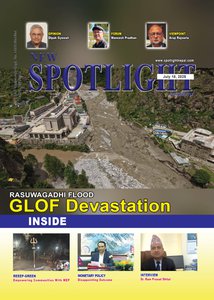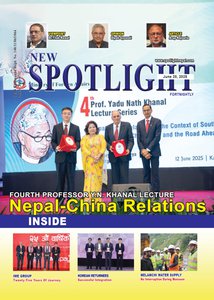The whistle echoes across the sun-baked plains of eastern Iran, a sound as old as the steam age, yet carrying the weight of a new world struggling to be born. It’s not the mournful cry of a ghost train, but the defiant blast of a freight locomotive pulling history behind it. This train, laden not with silks and spices, but with the hard currency of the 21st century – electronics, machinery, and the promise of connection – rolled into Tehran from Xi’an just weeks ago. Its arrival wasn't merely a logistical feat; it was a geopolitical earthquake, the tremor felt most acutely in the chancelleries of Washington, London, and Tel Aviv. This is the China-Iran corridor, a steel artery pumping lifeblood through the very heart of Eurasia, bypassing centuries of Western maritime dominion. And its timing, amidst the thunder of Israeli bombs falling on Iranian soil and the chilling echo of a US ambassador invoking Truman and the atomic spectre, is no accident. It’s the opening salvo in the battle for the soul of the 21st century.
Think of it as Mackinder’s nightmare – or his vindication, depending on your vantage point. Over a century ago, the British geographer Halford Mackinder, gazing at the vast, landlocked expanse he called the Eurasian "Heartland," penned his prophetic "Geographical Pivot of History." His thesis was stark: "Who rules East Europe commands the Heartland; who rules the Heartland commands the World-Island [Eurasia and Africa]; who rules the World-Island commands the world." For Mackinder, the key to global dominance lay not solely on the waves, where British gunboats enforced a Pax Britannica, but in the control of the immense continental interior. The completion of the Trans-Siberian Railway in 1916 was the first modern shudder of this reality, stitching Imperial Russia together and hinting at the power of land-based integration. It sent shivers through London. Now, the China-Iran corridor – a 10,400-kilometre rail link slashing the journey from China to Iran from 30-40 perilous sea days to a mere 15 – is the 21st-century fulfilment of that prophecy, a direct challenge to the maritime chokeholds the West has relied upon since Vasco da Gama.
This isn't just about shorter shipping times. It’s about sovereignty. For decades, the West, particularly the United States, has wielded control over the sea lanes like a trident. The Strait of Hormuz, that narrow Persian Gulf passage where 45% of China’s vital oil imports transit, wasn't just geography; it was a lever. Sanctions, blockades, the threat of naval interdiction – these were the tools used to enforce political will. The China-Iran corridor, snaking through the Central Asian republics of Kazakhstan, Uzbekistan, and Turkmenistan, bypasses Hormuz entirely. It renders those sanctions porous. It allows Iran, under the most brutal "maximum pressure" campaign, to still move its lifeblood – 90% of its oil exports now flow to China, constituting 16% of Beijing's total crude imports, a $25 billion lifeline. It’s a physical manifestation of defiance, a steel-clad middle finger to extraterritorial coercion. Imagine the frustration in Washington: their carefully constructed cage of sanctions suddenly has a landward door, wide open, with a "Welcome" sign written in Mandarin and Farsi.
And this corridor isn't an isolated track. It plugs directly into Russia’s International North-South Transport Corridor (INSTC), creating a vast, sanctions-resistant web across the Eurasian landmass. Iran transforms from pariah state to indispensable central transit hub, the pivot point connecting China’s colossal economy to Turkey, the Caucasus, the Persian Gulf states, and potentially Europe and Africa. This is the vision of the "Southern Trade Corridor" made real – a network consciously designed to operate outside Western-controlled financial systems (think de-dollarization) and logistical networks. It’s the infrastructure backbone of the emerging BRICS+ world, a tangible alternative to the Bretton Woods order. Turkey, a NATO member no less, eyeing BRICS membership, is the canary in the coal mine, signalling the fragmentation of old alliances.
So why the bombs? Why now? The timing of Israel’s extensive strikes on Iran’s nuclear facilities, particularly Natanz, mere weeks after that inaugural train triumphantly arrived in Tehran, reeks of more than just nonproliferation zeal. It smells of panic, of a desperate attempt to sever this nascent artery before it becomes too strong. The official Israeli line, that Iran was "racing toward a nuclear weapon," rings hollow against the stark counterpoint of US intelligence assessments concluding Tehran was still "years away" from weaponisation. This discrepancy isn't just bureaucratic noise; it’s the sound of a pretext being manufactured.
Then came the truly chilling echo. The US Ambassador to Israel invoking President Trump as "Truman." Why dredge up the ghost of the man who ordered the atomic obliteration of Hiroshima and Nagasaki? Historians have long debated the grim calculus of August 1945 – was it truly necessary to end the Pacific War, or was it, at least in part, a horrific demonstration of raw power aimed at a nascent Cold War rival, the Soviet Union? The ambassador’s reference feels less like historical reflection and more like a deliberate, ominous drumbeat. It evokes Truman’s willingness to deploy ultimate, civilisation-shattering force not strictly for military necessity, but for geopolitical messaging and dominance. To hear this echo now, directed at Iran, a nation actively building a vital corridor around Western power, is to feel the cold shadow of desperation falling across the discourse. CENTCOM’s rapid moves, shuffling carrier groups like chess pieces near Iran, amplify this sense of a script being followed – a script where overwhelming force, potentially nuclear, is the preferred response to geopolitical challenge. China’s stark warning that "regime change in Tehran" would unleash a "nightmare scenario" disrupting global energy flows isn't hyperbole; it’s a recognition of the stakes.
What’s truly at stake, beyond the immediate horror of potential conflict, is the future shape of our world. For the non-Western world, this corridor represents something profound: hope. Hope for energy security free from the threat of maritime strangulation. Hope for economic development financed not by the IMF’s austerity demands or the World Bank’s political conditionalities, but by sovereign partnerships like China’s Belt and Road Initiative (BRI). Hope that sanctions resistance can be more than just survival – it can be a path to prosperity, a model watched intently from Caracas to Pyongyang. It’s the hope that the "rules-based international order" might finally evolve into something genuinely multipolar, where different civilisations, different models of governance, can engage on terms of sovereign equality, not Western diktat.
The desperation emanating from Washington and its allies is palpable, and it stems from the dawning realisation that their centuries-old formula for dominance is rusting at the hinges. The maritime supremacy that underpinned 500 years of Western primacy – from Portuguese carracks to American carrier battle groups – is being circumvented by steel rails across the Heartland. The petrodollar, the lifeblood of US financial hegemony, bleeds out a little more with every barrel of Iranian oil sold to China in yuan or rials. And the very alliances that defined the post-WWII order, like NATO, show cracks as members like Turkey look East, seduced by the possibilities of this new Eurasian integration. It’s the sound of an old map, meticulously drawn in London and Washington, being crumpled up.
Picture the scene: that train, a modern-day Doctor Zhivago carriage traversing not snow-bound Russia but the windswept steppes and rugged mountains of Central Asia. It moves relentlessly forward, a symbol of patient, persistent construction. Contrast this with the sudden, violent explosions over Natanz – flashes of light seeking to shatter progress, reminiscent of the destructive climaxes in a thousand war films. This is the clash of epochs: the slow, determined build versus the desperate, destructive lash-out. It’s Kipling’s "Great Game" played with hypersonic missiles and blockchain transactions instead of spies and muzzle-loaders, with Mackinder’s ghost watching from the wings.
Amidst the darkness of Western bombs and nuclear sabre-rattling, this corridor, and the vision it represents, offers a powerful counter-narrative. It’s not about Chinese hegemony replacing American hegemony. It’s about sovereign choice. It’s about nations deciding their own paths, forging their own connections, and trading on their own terms. It’s about building a world with multiple poles, multiple voices, where security isn't guaranteed solely by aircraft carriers parked off your coast, but by mutually beneficial interdependence woven across continents.
The whistle blowing across the Iranian plateau is more than just noise. It’s a declaration. It announces that the Heartland, long dormant under the weight of colonial and Cold War divisions, is awakening. Mackinder’s pivot is no longer just theory; it’s becoming steel and commerce. The old powers, clinging to maps drawn in blood and ink from a fading era, hear that whistle as a death knell. For the rest of the world, the majority who have lived under the shadow of Western dominion for centuries, it sounds like the first, clear note of a dawn they have long awaited. The train is moving. The new map is being drawn. And no amount of bombs, however terrifying, can ultimately stop the relentless forward momentum of nations seeking their own destiny, connected not by the sea lanes of empire, but by the sovereign tracks of a multipolar future. The darkness of war is real, but the light on that eastern horizon, heralded by the iron horse, promises a brighter, more equitable dawn.
*Zakir Kibria is a writer and nicotine fugitive. Entrepreneur | Policy Analyst | Chronicler of Entropy | Cognitive Dissident. “Empires decay. Pragmatism
survives. Stay sarcastic.” Email: zk@krishikaaj.com
References & Key Data Points:
- China-Iran Corridor Inauguration & Route: First direct freight train from Xi'an, China, arrived in Tehran, Iran, in May 2025, covering ~10,400 km in 15 days. Route traverses Kazakhstan, Uzbekistan, Turkmenistan. (Source: Multiple reports including South China Morning Post, Eurasian Times - May 2025).
- Mackinder's Heartland Theory: Direct quote: “Who rules East Europe commands the Heartland; who rules the Heartland commands the World-Island; who rules the World-Island commands the world.” (Source: Halford Mackinder, "The Geographical Pivot of History," Geographical Journal, 1904).
- Strategic Importance of Hormuz: Approximately 45% of China's oil imports transit the Strait of Hormuz. (Source: TRT World analysis, various energy reports).
- China-Iran Oil Trade: China buys approximately 90% of Iran's oil exports, constituting roughly 16% of China's total crude oil imports. Estimated value ~$25 billion annually. (Source: Trade data aggregators like TankerTrackers.com, Reuters, pre-2025 sanctions estimates adjusted for current evasion).
- 1946 Iran Crisis: Soviet Union established short-lived separatist states (Azerbaijan People's Government, Republic of Mahabad) in Northern Iran post-WWII, only withdrawing under intense US/UK pressure, foreshadowing the Truman Doctrine. (Source: Historical accounts, e.g., The Cold War: A World History by Odd Arne Westad).
- U.S. vs. Israeli Intelligence Assessment on Iran Nukes (Pre-2025 Strikes): Persistent divergence, with Israel (e.g., PM Netanyahu) often claiming Iran was imminent or rapidly advancing, while US intelligence (e.g., DNI reports) consistently assessed Iran was not currently pursuing a weapon and that weaponization would take significant time (e.g., "at least a year" or more). (Source: Numerous reports from CNN, NYT, WaPo, citing US officials throughout 2023-2024).
- Impact of Sanctions on Russia-Europe Rail Trade: Westbound rail freight volumes from China to Europe via Russia collapsed by approximately 51% in 2023 due to sanctions and insurance issues. (Source: Freight analysis firms, e.g., RailFreight.com, FPRI reports).
- China's Warning on Regime Change: Chinese Foreign Ministry spokespersons and officials repeatedly warned against external interference in Iran, stating it would lead to "chaos" and regional instability, particularly referencing energy security. (Source: Official Chinese Foreign Ministry statements, May 2025).
Further Reading:
- Halford Mackinder: Democratic Ideals and Reality (1919) - Expanded his Heartland theory.
- Robert D. Kaplan: The Revenge of Geography (2012) - Explores Mackinder's enduring relevance.
- Peter Frankopan: The New Silk Roads: The Present and Future of the World (2018) - Details the rise of East-West land corridors.
- Pepe Escobar: Raging Twenties columns (Asia Times, Consortium News) - Geopolitical analysis focusing on Eurasian integration and multipolarity.
- Alfred W. McCoy: To Govern the Globe: World Orders and Catastrophic Change (2021) - Historical context on shifting world orders and challenges to US dominance.
- Eurasian Times / South China Morning Post / TRT World: Ongoing reporting on the China-Iran corridor, Central Asian geopolitics, and the emerging multipolar order.
- The Tehran Gambit: How America’s War on Iran Accelerated the Birth of a Post-Western World
- Aug 05, 2025
- The Digital Strip Search: How America’s Social Media Visa Edicts Redraw Colonial Borders in Cyberspace
- Jul 14, 2025
- The Kuala Lumpur Pivot: How A Silent Summit In Malaysia Is Rewriting The Global Economic Map
- Jun 16, 2025
- The Rise of Mediation Diplomacy – How Hong Kong’s IOMed Charts a New Path for a Multipolar World
- May 28, 2025
- Rivers as Narratives of Peace in South Asia
- May 18, 2025


